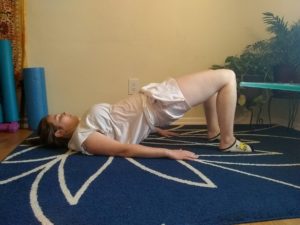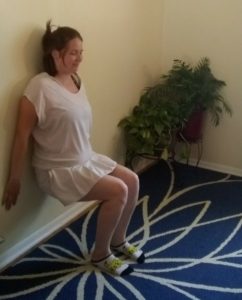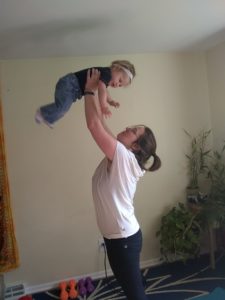Updated October, 2021
Your pelvic floor muscles are exactly what they sound like: the muscles that span the area underneath the pelvis. Just like your other muscles, you need to do exercises to strengthen your pelvic floor muscles, especially after giving birth.
When you hear about women who pee a little when they sneeze after they give birth, or they can’t jump without wearing a pad, this is a result of the weakening of the pelvic floor. This is normal shortly after birth, but it is not something you should deal with for the rest of your life.
Through regular exercise both leading up to and after birth, you can help improve the strength of your pelvic floor muscles. Most people know this exercise as a Kegel. In fact, women who practice Kegel exercises before birth often find they have an easier birth because you can develop the ability to control your muscles during labor and delivery.
How To:
Find the right muscles
The most common suggestion for finding your pelvic floor muscles is to stop the flow of urine when using the bathroom, although you don’t want to do this too often because it can increase your chance of urinary infection.
Those are the muscles you are going to try contracting. Get comfortable with those muscles as you are going to be working them without a toilet in the future.
Squeeze
Once you have found the right muscles, it’s time to start practicing. What you are able to accomplish initially may not be a lot. You are essentially going to contract the pelvic floor muscles and then relax them. Think squeezing or flexing those muscles.
To check if you are successful, you can insert a finger into your vagina and you should be able to feel yourself squeezing. No pressure if that’s awkward for you, but it is an option and is arguably the best way to know for sure that you are contracting the correct muscles.
Quick Squeeze
There are two types of exercise that fall under the category of a kegel. The quick squeeze is exactly what it sounds like. You want to quickly squeeze and release 20 or 30 times in a row. This might start out at only 5 squeezes before your muscles fatigue, but you can work your way up to 30.
Long Squeeze
The longer squeeze is more of a hold to help tone and strengthen your pelvic floor muscles over time. You want to contract your muscles for ten seconds, then relax. You may start out at 5 seconds, or even two seconds, but work your way up to ten. Repeat for 10-20 times.
Practice Often
Practice. And I mean often. This is likely an exercise that you will need to regularly do for the rest of your life. One of my favorite things about kegels is that if you forget for awhile, and start having problems again, you can come back to them and start practicing again. And once again, with time, your muscles will tone up.
Kegels can be done anytime and anywhere. I found driving was great, especially at red lights or stop signs. Waiting in line at the grocery store was also great, as well as for a minute in bed before going to sleep for the night. Find a time that works in your day to integrate them and make sure you are doing them.
Make It Fun
Okay, I have to admit, despite knowing how to do kegels (I thought) I felt like I was still struggling and I started having some pretty bad urinary incontinence. I decided I needed some help and purchased two products. Let me start by warning you that this investment might feel a little steep, but it’s more than worth it.
The first are your standard Ben Wa Balls. I bought a pack of 6 different weights. They came in a nice little box and had a basic set of instructions. The idea with these is that you insert them into your vagina (they recommend around 30 minutes per day) and walk about doing your regular routine. This can be cooking dinner, cleaning the house, playing with kids. Whatever. It helps with overall toning and strengthening.
Unfortunately, because my incontinence had gotten so bad, I completely convinced myself that I had to be doing my kegels wrong. So I also invested in the Perifit, which has biofeedback sensors. My favorite part about this is that I get to work my pelvic floor muscles AND play games. Now there were cheaper options than the Perifit, but I specifically wanted one that I could play games with. Yeah, we all have our thing.
Results
If you already have concerns around the strength of your pelvic floor muscles, results can take awhile. You will know your kegels are working when you have better bladder control and the ability to hold the contractions longer. There have also been a few studies that report that women who do kegels regularly obtain orgasm more easily, frequently, and intensely. So that’s a perk too.
Other Exercises
If you are anything like me, you want to know if there are other exercises you can do to help strengthen your pelvic floor muscles. I’m excited to report that yes, there are four that I have been able to find. Now these don’t take the place of kegels, but they can help improve your body and overall pelvic floor muscles.
Bridge
Lie on your back with your knees bent and feet flat on the floor. Inhale, engage your pelvic floor, and lift your hips. Hold for 10 seconds (keep breathing). Lower your hips back down and release your pelvic floor. Do 10 reps.


Wall Sit
Stand against a wall, feet hip-width apart. Inhale, engage your pelvic floor, and lower yourself into a squat as though sitting in a chair. Hold for 10 seconds. Rise back up to standing and release your pelvic floor. Rest for 10 seconds. Do 10 reps.

Jumping Jacks
Start with your legs together. Engage your pelvic floor as you jump your legs apart and bring your arms overhead. Release your pelvic floor as you hop your legs back together. Repeat for 30 to 60 seconds.


Dead Bug Crunch
Lie on your back with your legs in table top position and your arms straight toward the ceiling. Inhale, engage your pelvic floor, and extend your right arm beyond your head and left leg forward. Release your pelvic floor and draw your arm and leg back to the starting position. Repeat with left arm and right leg. Do 10 reps on each side.


Physical Therapy
After Rainbow was born, I had maxed my out of pocket deductible so I decided to seek physical therapy as well. I must say, if you can get insurance to cover it, or you can afford it yourself, seek out a physical therapist that specializes in the pelvic floor muscles. They can really help your pelvic floor recovery go to the next level.
Medical Disclaimer
All of the information on this site assumes that the individual is in good physical and mental health, and that her pregnancy was without risk factors or complications. Web site content is for informational purposes only and is not intended to offer medical advice, or replace the recommendations of your doctor, midwife, or physical therapist. Always consult your doctor before beginning any exercise program.


















